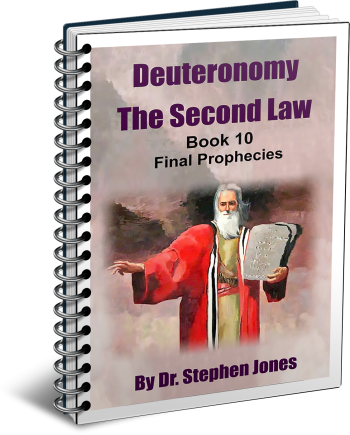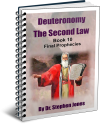Latest Posts
View the latest posts in an easy-to-read list format, with filtering options.

A commentary on the tenth speech of Moses in Deuteronomy 32-34. The book of Deuteronomy is a series of 12 speeches that Moses gave just before his death at the end of Israel's wilderness journey.
Category - Bible Commentaries

In accordance with the parallelism explained in Part 1, Deut. 32:20 is “D” that draws near to the midpoint (“E”) of Moses’ carefully crafted structure for his Song.
By this point it may be clear that Moses’ thoughts also follow a chronological order in each section.
Section A, “Call to Hear,” shows God’s call to Israel when He brought them out of Egypt.
Section B, “Goodness and bounty for Yahweh’s goodness,” is the giving of the laws of the Kingdom, which, if men would follow, goodness and bounty would follow them. This covers their wilderness journey.
Section C, “Israel’s evil return for Yahweh’s goodness,” shows Israel’s response during their sojourn in Canaan from Joshua until the time of captivity.
Section D, “Divine reflections on Lo-ammi” (not My people), brings us to the time when God cast Israel out of the land and made her “not My people.” This represents the low point in Kingdom history before God begins to rectify the situation.
Section E, “Yahweh’s provocation of Israel” shows how God provokes Israel to jealousy in order to turn the hearts of the people back to Him.
Section E2, “Yahweh’s threats of judgment,” runs parallel to Section E, showing how divine judgment itself was designed to cause the people to repent.
Section D2, “Divine reflections on “Jezreel” (God scatters), runs parallel to Section D, as we see from the book of Hosea. Lo-ammi and Jezreel were the two sons of Hosea.
Section C2, “Israel’s evil return for Yahweh’s goodness,” runs parallel to Section C, covering Israel’s history throughout the time of the “beast” empires. Israel did evil in the land of Canaan and were judged by six distinct captivities. So also did they continue doing evil after the Assyrians took them into the great captivity.
Section B2, “Judgments of Yahweh upon Israel,” runs parallel to Section B, but shows the judgment of the law for disobedience, instead of the bounty of God.
Section A2, “Call to rejoice,” runs parallel to Section A, because the judgments of God are followed by the resolution of the conflict between God and Israel. All nations will then rejoice with Israel, because they too will be set free from the beast system that has ruled all nations for millennia.
We see, then, that Moses follows a chronological order of history, revealing the divine plan for the salvation, not only of Israel, but of all nations.
So with this in mind, we now focus on Section D, where Moses foretells the time when Israel would become “not My people.” Keep in mind that the Old Covenant stated that if the people would obey God’s voice, then and only then would they be God’s people (Exodus 19:5). The New Covenant promised to make Israel His people (Deut. 29:13). It is clear, then, that being God’s people was not based on their genealogy from Abraham, Isaac, and Jacob, but upon their faith and obedience. Those without faith cannot please God (Heb. 11:6), even if they show Him their impeccable pedigree.
It is clear from history that Israel in the flesh failed to live up to the standard of the divine law. After centuries of disobedience, when their flesh had proven itself incapable (as a nation) to bring forth the fruit that God desired and demanded, the nation was sent into captivity, and God pronounced them “not My people.”
This time is explained in greater detail in the prophecy of Hosea, the prophet who was instructed to marry a harlot named Gomer. She bore him three children: a son named Jezreel, a daughter named Lo-ruhamah, and a son named Lo-ammi.
Gomer herself represented the House of Israel, for the Assyrians knew Israel by the name Gomer, or Gamir. The people of Gamir were known as Ghomri or Gamirri. The name was derived from Israel’s King Omri, which appeared in the old Hebrew text as Ghomri. As time passed, the name was altered slightly to Khumri or Humria.
This is the name shown on the Black Obelisk of Shalmanezer, which pictures the king of Israel, “Jehu, mar Humria,” bowing down to King Shalmanezer of Assyria and paying tribute to him. The Wikipedia shows a picture of this obelisk and says of the inscription:
Jehu severed Israel’s alliances with Phoenicia and Judah, and became subject to Assyria. The caption above the scene, written in Assyrian cuneiform, can be translated:
“The tribute of Jehu, son of Omri: I received from him silver, gold, a golden bowl, a golden vase with pointed bottom, golden tumblers, golden buckets, tin, a staff for a king [and] spears."
In the Obelisk, Jehu's name appears as mIa-ú-a mar mHu-um-ri-i, or "Jehu son of Omri (Bit-Khumri").
http://en.wikipedia.org/wiki/Black_Obelisk
We see that the Assyrian language reads Jehu mar Humri, but the Hebrew language reads Jehu, bit-Khumri. They mean the same: Jehu, son of Omri.
So it was prophetic that the prophet was led to marry a harlot named Gomer, or Khumri, because her name was literally what the Assyrians called Israel in those days. The Assyrians called Israel, “The House of Omri.” In fact, it is largely because of this name change that the Israelites were lost for many centuries. The other nations did not refer to them in their official records as Israel, but as Khumri.
Though they became the “lost tribes of Israel,” the people themselves did not disappear, but rather they were known by the names that the nations called them. We know now that after the fall of Assyria, the Ghomri, or Khumri, immigrated into Europe, Britain, and Ireland as the Khumri, Kimmeroi (Cimmerians), Cambrians, Kelts, Celts, etc.
For further information on this (and more), see my book, Who is an Israelite?
Hosea’s prophecy shows that Israel was a harlot who committed spiritual adultery against God by following after other gods. As a result, Gomer’s children were named prophetically, showing how those fleshly Israelites were “scattered” (Jezreel), “not pitied” (Lo-ruhamah), and “not My people” (Lo-ammi).
The name, Lo-ammi, is of particular interest to us at the moment, for it is the topic of Moses’ Song in Deut. 32:20,
20 Then He said, “I will hide My face from them,
I will see what their end shall be;
For they are a perverse generation,
Sons in whom is no faithfulness.”
Hosea’s prophecy interprets and clarifies Moses’ words in terms of a failed marriage, due to adultery. First, God hides His face from Israel. The word “face” is the Hebrew word is paniym, which means “face, presence.” In the context of marriage, it indicates separation or divorce. The stated reason is “they are a perverse generation.” The harlot is perverse, tahpukah, which comes from the root word, hafak, “to turn, overturn, overthrow.”
In a moral sense, it means “deceit,” where one turns from doing what he or she has promised to do. In other words, Israel-Gomer broke her marriage vow. It also implies that here children, the Israelites themselves, were to be overthrown on account of their perversity or deceit—that is, on account of her harlotry. In other words, the individual Israelites were as deceitful as their mother, the nation.
Moses equates the Israelites to “sons in whom is no faithfulness.” The Hebrew word for “faithfulness” is amun, “faithful, trustworthy, truthful.” The root word is aman, or “amen,” which comes out in the New Testament Greek as “verily,” or “of a truth.” The Hebrew court of law often required men to swear an oath of innocence, saying, “Amen, Amen,” or “Verily, Verily.” It indicated agreement.
This was also the Hebrew word for Faith. So Moses was telling us that the sons of Israel had no faith. They could not be trusted to tell the truth, nor could God trust them to do what they said they would do. Neither were they in agreement with God, for in spite of their vows of compliance and obedience, they continually disagreed with the law and will of God.
And so, these “sons,” by Hebrew metaphor, were “not My people.” In other words, God disclaimed them because they were nothing like Him. There was no resemblance between God and the Israelites. Hosea implied that they were children of harlotry, children of a false god. They were certainly “children of their mother,” but Hosea questioned the paternity of his son, Lo-ammi. His son looked nothing like him, and so he said, “He can’t be my son.” This became the occasion for his name, “not My people.”
The lesson here is that apart from faith, we bear no resemblance to our heavenly Father. Without faith, we are Lo-ammi, for God repudiates us, saying, “these are not my children.” When it is known that the mother is a harlot, the paternity of all her children comes into question.
So God looks at the sons of Israel (Gomer) and reflects on the way they look and act to see if they are really His children or not. In his Song, Moses says that God’s verdict is to hide His face from Israel-Gomer and to send her out of the house according to the laws of divorce (Deut. 24:1-4). So she and her children of harlotry were taken by the Assyrians into captivity to suffer the consequences of spiritual adultery.
It is plain from this that the concept of the sons of God has nothing to do with one’s physical genealogy. The Israelites were repudiated as false sons, regardless of their genealogy from Abraham, Isaac, and Jacob. The New Testament shows that to become the sons of God, one must have faith in Jesus Christ, and the Holy Spirit must beget Christ in each of us in a spiritual way.